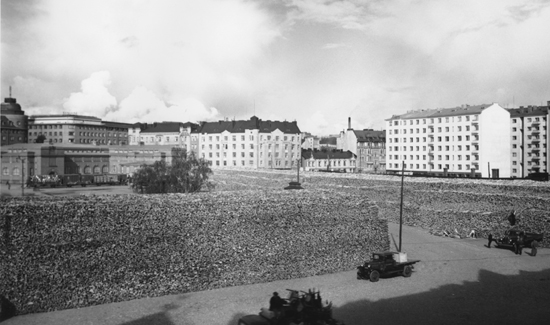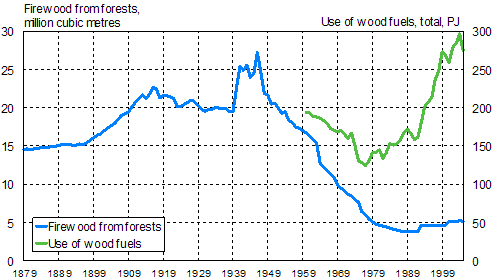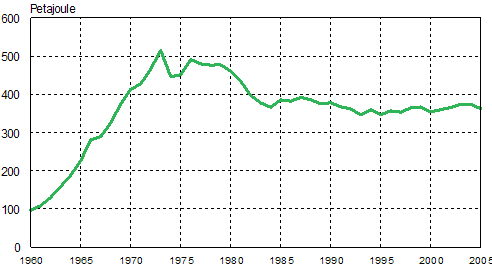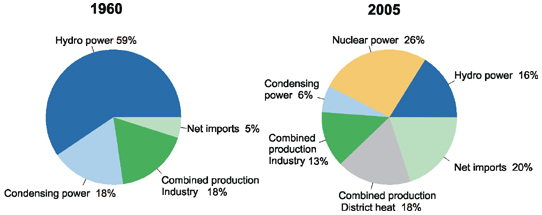The use and sources of energy 1917-2007
When Finland gained independence in 1917, most of the timber felled annually from its forests was used as firewood. The use of wood for heating decreased rapidly but its use in the forest industry did not start to grow until after the Second World War. The use of fossil fuels began to increase fast in the 1960s. The energy crisis of the 1970s clearly slowed down this growth, and even brought it to a halt, but Finland still continues to be heavily dependent on fossil fuels. As late as in the 1960s, most of the country's electricity was still generated with hydro power. Thermal power was first generated with coal and oil, followed later by peat, natural gas and, from the late 1970s onwards, nuclear power.

Firewood for Helsinki was stored on Hakaniementori
square during both world wars.
Source: Helsinki City Museum
Wood is used more and more efficiently
In the early days of Finnish independence, annual fellings from its forests amounted to nearly 30 million cubic metres, and over 20 million cubic metres of the total were used as firewood (Figure 1). During the Second World War, firewood fellings could total as much as 25 million cubic metres per year. The firewood was sold as metre-long split billets, and neat stacks of them could still be seen throughout Finnish countryside and towns in the 1960s. Besides for heating buildings, wood was also used in steam engines and boats.
Fellings of wood for energy decreased steadily right up to the 1990s, and since then their annual volume has amounted to around five million cubic metres. However, total felling volumes have been going up strongly ever since the beginning of last century. Today, the amount of timber felled from Finnish forests every year exceeds 60 million cubic metres but this is still less than their natural annual increment of stock. In addition to this, Finland imports around 16 million cubic metres of roundwood. Most of the wood is used as raw material in the forest industry.
Although the fellings of wood for energy have diminished, wood still plays an important role in Finland's energy economy. In 2005, one-fifth of the total amount of energy consumed in the country was generated with wood-based fuels. Small combustion of wood only accounts for a minor share, but wood-based energy is produced with waste wood and bark from sawmills and plywood factories, and with black liquor from the pulp industry. Goals dictated by both economics and protection of the environment have been the driving forces for improving the forest industry's efficiency in the use of wood material and for finding ways of saving energy.
Figure 1. Use of firewood and other wood-based energy in Finland

The record amounts of firewood felled by volunteers during World War II can be seen as a peak in the time series describing the volume of forest fellings for firewood. Since the war, the use of firewood has been diminishing fast, whereas that of other wood-based fuels has been clearly increasing.
Sources: Statistical Yearbook of Forestry and Online service of Energy Statistics
Fossil fuels have retained their strong place
The use of fossil fuels - oil, natural gas and coal - increased in Finland through the first decades of independence and right up to the energy crisis of the early 1970s. Then the pace of growth slowed down, and even came to a halt. The amounts of fossil fuels used today are around 500-fold compared to 1917.
The use of oil increased very quickly in the 1960s (Figure 2). It was needed by the rapidly growing number of motor cars and used ever more widely for heating and even for generating electricity at power plants as it was still cheap at that time. People in the countryside were pulling down their wood-burning heating stoves and buying oil heaters in their place. Home produced energy was replaced with imported energy.
The consumption of oil increased 5-fold in Finland from 1960 up to the peak year of 1973, when it halted. The crisis in the Middle East led to the use of oil as a political weapon and to the founding of the Organisation of Petroleum Exporting Countries (OPEC). The oil crisis acted as a catalyst for finding ways of saving energy and speeded up the exploration of alternative energy sources alongside oil and other fossil fuels. However, it is very difficult to discard oil completely while transport equipment, for instance, mainly run on fossil fuels.
Figure 2. Oil consumption in Finland 1960-2005

Source: Online service of Energy Statistics
In addition to oil, the fossil fuels used in Finland are coal and natural gas, whose use increased when a gas pipeline was opened from the then Soviet Union to Finland in 1974. Both coal and natural gas are mainly used in industry and in heat and electricity production at power plants.
Large-scale use of peat for energy production began after the 1970s energy crisis. In Finland, peat is regarded as a slowly renewable biomass fuel, but in greenhouse gas emission calculations it is treated as a fossil fuel. The Kyoto Protocol became effective in 2005, and the European Union's trading scheme in quotas of carbon dioxide emissions from fossil fuels and peat started in the same year. These will set limits on the future use of fossil fuels in energy production.
Generation of electricity has diversified
In 1917, consumption of electricity in Finland totalled 205 gigawatt hours (GWh, Table 1.) In the 90 years of Finland's independence the consumption has grown 400-fold to around 86,000GWh. The growth in the use of electricity was fastest between the two World Wars, but it still continues. An ever increasing share of energy is consumed as electricity. Industry uses more than half of all electricity while ten per cent of it is used for electric heating.
Table 1. Consumption of energy in Finland 1885-2005
| Use of fossil fuels | Electricity consumption |
Fellings of firewood | |
| PJ | GWh | Million m3 | |
| 1885 | 2 | 0 | 15 |
| 1890 | 2 | 1 | 15 |
| 1895 | 2 | 2 | 15 |
| 1900 | 6 | 17 | 16 |
| 1905 | 6 | 28 | 18 |
| 1910 | 11 | 90 | 20 |
| 1915 | 1 | 211 | 22 |
| 1917 | 1 | 205 | 23 |
| 1920 | 5 | 289 | 22 |
| 1925 | 14 | 607 | 20 |
| 1930 | 32 | 1,206 | 20 |
| 1935 | 46 | 2,095 | 20 |
| 1940 | 36 | 1,789 | 23 |
| 1945 | 13 | 2,959 | 25 |
| 1950 | 80 | 4,164 | 20 |
| 1955 | 121 | 6,824 | 18 |
| 1960 | 174 | 8,789 | 17 |
| 1965 | 292 | 14,242 | 12 |
| 1970 | 509 | 21,817 | 10 |
| 1975 | 574 | 29,176 | 8 |
| 1980 | 686 | 39,921 | 5 |
| 1985 | 628 | 52,043 | 4 |
| 1990 | 692 | 62,334 | 3 |
| 1995 | 706 | 68,946 | 5 |
| 2000 | 706 | 79,158 | 5 |
| 2005 | 709 | 84,797 | 5 |
For sources, see List of sources and links at the end
Up to the beginning of the 1970s, electricity was mainly generated with hydro power. The construction of the Imatra hydro power plant was started in 1922 and the plant, which at that time was the largest of its kind in Europe, was completed and began to produce electricity in 1929. The Imatra power plant is still the largest hydro power plant in Finland, producing electricity with seven units.
Thermal power was first generated with coal and oil, followed later by peat, natural gas and, from the late 1970s onwards, nuclear power. Combined production of heat and power began in industry. The production of district heat for heating buildings started in the 1960s. Today, more than half of the energy for heating buildings is district heat.
At the moment, around a quarter of the electricity used in Finland is produced with nuclear power (Figure 3). The first four nuclear power plants in Finland were built at the turns of the 1970s and 1980s and roused no major political discussion. In 1986, a tragic accident took place in the Chernobyl nuclear power plant in Ukraine, and subsequent to it nuclear power plant projects were put on ice almost everywhere. The Finnish Parliament voted against the fifth nuclear power plant in 1993 but decided in favour of its construction in 2002. The construction began in 2003.
Around one-fifth of the electricity used in Finland is imported. Finland has also been part of the joint Nordic electricity market since 1998. Imports from the Nordic countries fluctuate dependent on the hydro power situation in Norway and Sweden. Electricity is also imported to Finland from Russia and since 2007 from Estonia.
Figure 3. Electricity supply

Source: Online service of Energy Statistics
Energy statistics
The compilation of energy statistics was not started until after the 1970s energy crisis good three decades ago. The first compendium publication of energy statistics was compiled by the Ministry of Trade and Industry in 1976.
The actual, systematic energy statistics contain time series starting from the statistical reference year of 1960. Separate data on e.g. electricity production or forest fellings are available from other statistics for the years prior to this. The main responsibility for the compilation of energy statistics was assigned to Statistics Finland in the 1990s.
Inquiries: Mr Leo Kolttola +358 9 1734 3234, Statistics Finland
Sources and links
- Home pages of Energy Statistics on
the Internet
Statistics describing energy production, consumption, imports, exports, prices and investments, and information about their compilation methods. The topic also extends to statistics describing emissions to the environment from the consumption and production of energy. - Online service of Energy
Statistics (in Finnish)
Data on energy consumption, production and prices, and on foreign trade in energy. The service contains statistics on energy and emissions in Finland as well as international comparison data. The service is in three languages, Finnish, Swedish and English. - Greenhouse Gas
Inventory
Statistics Finland's Greenhouse Gas Inventory unit is responsible for the compiling and reporting of the Finnish Greenhouse Gas Inventory under the UNFCCC. - Statistical
Yearbook of Forestry.
Forest fellings, forest resources, firewood fellings and use of wood-based energy. Published by the Finnish Forest Research Institute Metla - IEA International Energy Agency
- Table 1, sources:
Keskinen, R. 1993. Suomen energiatekniikan historia (history of energy technology in Finland) 1840-1980. Tampere 1993
Salonen, Timo 1981. Dynaamiset markkinatalousmallit energiataloudessa (dynamic market economy models for energy economy). Helsinki University of Technology, Master's thesis
Vattula, K. (ed.) 1983. Suomen taloushistoria, Osa 3. (economic history of Finland, Part 3). Helsinki. Tammi Oy
Online service of Energy Statistics
Statistical Yearbook of Forestry.
Last updated 30.3.2007
